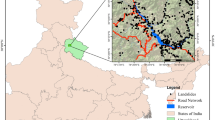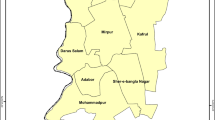Abstract
The landslide susceptibility (LS) of any mountainous region is significantly affected by the land-use land-cover (LULC) change. Recently, LULC change effects on landslides have been investigated by many researchers. However, the future prediction of the LS using these LULC changes has not been quantified. The main objective of this study is to predict the future LS map considering the future LULC change scenario for the Tehri region, India. To achieve this objective, we first prepared a geospatial database of past landslide events. These events data were clustered into three major temporal categories, 2005–2010, 2010–2015, and 2015–2020. Second, the artificial neural network (ANN) approach was adopted to prepare LS maps for the years 2010, 2015, and 2020. Then, for the same years, LULC maps were also developed. Third, the future scenario of LULC for the year 2030 was simulated using the ANN-cellular automata model, and the future LULC changes were derived using the change detection technique. Finally, the future LS map for 2030 was projected using derived future LULC changes. The LULC change results reveal that the region is expected to see a significant growth in the built-up area by 34.1%, water body by 6.3%, and agriculture land by 1%. Further, a shrink in dense forest area by 2.4% and sparse forest area by 0.9% is expected in the future. Additionally, the projected LS results reveal a 33% increment in the very high LS zone. This information about the increase in future LS due to rapid urban growth in the mountains can help the various government agencies to scientifically plan the various developmental activities.












Similar content being viewed by others
References
Abancó C, Hürlimann M (2014) Estimate of the debris-flow entrainment using field and topographical data. Nat Hazards 71(1):363–383
Al-Najjar HA, Kalantar B, Pradhan B, Saeidi V (2019) Conditioning factor determination for mapping and prediction of landslide susceptibility using machine learning algorithms. In Earth resources and environmental remote sensing/GIS applications X (Vol. 11156, p. 111560K). Int Soc Opt Photonics. https://doi.org/10.1117/12.2532687
Araya YH, Cabral P (2010) Analysis and modeling of urban land cover change in Setúbal and Sesimbra. Portugal Remote Sens 2(6):1549–1563. https://doi.org/10.3390/rs2061549
Basse RM, Omrani H, Charif O, Gerber P, Bódis K (2014) Land use changes modelling using advanced methods: Cellular automata and artificial neural networks. The spatial and explicit representation of land cover dynamics at the cross-border region scale. Appl Geogr 53:160–171. https://doi.org/10.1016/j.apgeog.2014.06.016
Bayat M, Ghorbanpour M, Zare R, Jaafari A, Pham BT (2019) Application of artificial neural networks for predicting tree survival and mortality in the Hyrcanian forest of Iran. Comput Electron Agric 164:104929. https://doi.org/10.1016/j.compag.2019.104929
Caniani D, Pascale S, Sdao F, Sole A (2008) Neural networks and landslide susceptibility: a case study of the urban area of Potenza. Nat Hazards 45(1):55–72. https://doi.org/10.1007/s11069-007-9169-3
Chen L, Guo Z, Yin K, Shrestha DP, Jin S (2019) The influence of land use and land cover change on landslide susceptibility: a case study in Zhushan Town, Xuan’en County (Hubei, China). Nat Hazard 19(10):2207–2228. https://doi.org/10.5194/nhess-19-2207-2019
Chung ES, Park K, Lee KS (2011) The relative impacts of climate change and urbanization on the hydrological response of a Korean urban watershed. Hydrol Process 25(4):544–560. https://doi.org/10.1002/hyp.7781
Ghestem M, Sidle RC, Stokes A (2011) The influence of plant root systems on subsurface flow: implications for slope stability. Bioscience 61(11):869–879. https://doi.org/10.1525/bio.2011.61.11.6
Ghestem M, Veylon G, Bernard A, Vanel Q, Stokes A (2014) Influence of plant root system morphology and architectural traits on soil shear resistance. Plant Soil 377(1):43–61. https://doi.org/10.1007/s11104-012-1572-1
Ghosh JK, Bhattacharya D (2010) Knowledge-based landslide susceptibility zonation system. J Comput Civ Eng 24(4):325–334
Green GM, Ahearn SC (2016) Modelling forest canopy trends with on-demand spatial simulation. Int J Geogr Inf Sci 30(1):61–73. https://doi.org/10.1080/13658816.2015.1066791
Gupta P, Anbalagan R (1997) Slope stability of Tehri Dam Reservoir Area, India, using landslide hazard zonation (LHZ) mapping. Q J Eng Geol 30(1):27–36. https://doi.org/10.1144/GSL.QJEGH.1997.030.P1.03
Hürlimann M, Guo Z, Puig-Polo C, Medina V (2021) Impacts of future climate and land cover changes on landslide susceptibility: regional scale modelling in the Val d’Aran region (Pyrenees, Spain). Landslides. https://doi.org/10.1007/s10346-021-01775-6
Huffman GJ, Stocker EF, Bolvin DT, Nelkin EJ, Tan J (2019) GPM IMERG Early Precipitation L3 Half Hourly 0.1 degree x 0.1 degree V06, Greenbelt, MD, Goddard Earth Sciences Data and Information Services Center (GES DISC). Accessed 20 April 2022. https://doi.org/10.5067/GPM/IMERG/3B-HH-E/06
Jacinth Jennifer J, Saravanan S (2021) Artificial neural network and sensitivity analysis in the landslide susceptibility mapping of Idukki district. India Geocarto International. https://doi.org/10.1080/10106049.2021.1923831
James N, Sitharam TG (2014) Assessment of seismically induced landslide hazard for the State of Karnataka using GIS technique. J Indian Soc Remote Sens 42(1):73–89.https://doi.org/10.1007/s12524-013-0306-z
Jenness J, Wynne JJ (2005) Cohen's Kappa and classification table metrics 2.0: An ArcView 3. x extension for accuracy assessment of spatially explicit models. Open-File Report OF 2005–1363. Flagstaff, AZ: US Geological Survey. Southwest Biological Science Center. 86 p
Joshi V, Murthy TVR, Arya AS, Narayana A, Naithani AK, Garg JK (2003) Landslide hazard zonation of Dharasu-Tehri-Ghansali area of Garhwal Himalaya, India using remote sensing and GIS techniques. Journal of Nepal Geological Society 28:85–94. https://doi.org/10.3126/jngs.v28i0.31727
Karl TR, Trenberth KE (2003) Modern Global Climate Change Science 302(5651):1719–1723. https://doi.org/10.1126/science.1090228
Ku CA (2016) Incorporating spatial regression model into cellular automata for simulating land use change. Appl Geogr 69:1–9. https://doi.org/10.1016/j.apgeog.2016.02.005
Kumar R, Anbalagan R (2016) Landslide susceptibility mapping using analytical hierarchy process (AHP) in Tehri reservoir rim region, Uttarakhand. J Geol Soc India 87(3):271–286
Kumar R, Anbalagan R (2015) Landslide susceptibility zonation in part of Tehri reservoir region using frequency ratio, fuzzy logic and GIS. J Earth Syst Sci 124(2):431–448. https://doi.org/10.1007/s12040-015-0536-2
Kumar A, Sharma MP (2016) Assessment of risk of GHG emissions from Tehri hydropower reservoir, India. Hum Ecol Risk Assess Int J 22(1):71–85
Landis JR, Koch GG (1977) The measurement of observer agreement for categorical data. Biometrics 159–174
Li X, Yeh AGO (2002) Neural-network-based cellular automata for simulating multiple land use changes using GIS. Int J Geogr Inf Sci 16(4):323–343. https://doi.org/10.1080/13658810210137004
Lopez-Saez J, Corona C, Eckert N, Stoffel M, Bourrier F, Berger F (2016) Impacts of land-use and land-cover changes on rockfall propagation: Insights from the Grenoble conurbation. Sci Total Environ 547:345–355. https://doi.org/10.1016/j.scitotenv.2015.12.148
Márquez AM, Guevara E, Rey D (2019) Hybrid model for forecasting of changes in land use and land cover using satellite techniques. IEEE J Sel Top Appl Earth Obs Remote Sens 12(1):252–273. https://doi.org/10.1109/JSTARS.2018.2885612
McNally A (2018) FLDAS noah land surface model L4 global monthly 0.1× 0.1 degree (MERRA-2 and CHIRPS). Atmos Compos Water Energy Cycles Clim Var
Meneses BM, Pereira S, Reis E (2019) Effects of different land use and land cover data on the landslide susceptibility zonation of road networks. Nat Hazards Earth Syst Sci 19(3):471-487. https://doi.org/10.5194/nhess-19-471-2019
Naithani S, Saha AK (2019) Changing landscape and ecotourism development in a large dam site: a case study of Tehri dam, India. Asia Pacific Journal of Tourism Research 24(3):193–205. https://doi.org/10.1080/10941665.2018.1557226
Nicu IC (2018) Application of analytic hierarchy process, frequency ratio, and statistical index to landslide susceptibility: an approach to endangered cultural heritage. Environmental Earth Sciences 77(3):1–16. https://doi.org/10.1007/s12665-018-7261-5
Oleson KW, Bonan GB, Feddema J, Vertenstein M (2008) An urban parameterization for a global climate model. Part I: Formulation and evaluation for two cities. J App Meteorol Climatol 47(4):1038–1060
Pande RK (2006) Landslide of Rishikesh‐Badrinath National Highway at Devprayag, District Tehri Garhwal, Uttaranchal (India). Disaster Prevention and Management: An Int J. https://doi.org/10.1108/09653560610659801
Patra S, Sahoo S, Mishra P, Mahapatra SC (2018) Impacts of urbanization on land use/cover changes and its probable implications on local climate and groundwater level. Journal of Urban Management 7(2):70–84. https://doi.org/10.1016/j.jum.2018.04.006
Pham QB, Chandra Pal S, Chakrabortty R, Saha A, Janizadeh S, Ahmadi K, Bannari A (2021) Predicting landslide susceptibility based on decision tree machine learning models under climate and land use changes. Geocarto Int. https://doi.org/10.1080/10106049.2021.1986579
Pinyol NM, Alonso EE, Corominas J, Moya J (2012) Canelles landslide: modelling rapid drawdown and fast potential sliding. Landslides 9(1):33–51. https://doi.org/10.1007/s10346-011-0264-x
Pisano L, Zumpano V, Malek Ž, Rosskopf CM, Parise M (2017) Variations in the susceptibility to landslides, as a consequence of land cover changes: A look to the past, and another towards the future. Sci Total Environ 601:1147–1159. https://doi.org/10.1016/j.scitotenv.2017.05.231
Promper C, Gassner C, Glade T (2015) Spatiotemporal patterns of landslide exposure–a step within future landslide risk analysis on a regional scale applied in Waidhofen/Ybbs Austria. Int J Disaster Risk Reduction 12:25–33.https://doi.org/10.1016/j.ijdrr.2014.11.003
Reichenbach P, Mondini AC, Rossi M (2014) The influence of land use change on landslide susceptibility zonation: the Briga catchment test site (Messina, Italy). Environ Manage 54(6):1372–1384
Roy PS, Roy A (2010) Land use and land cover change in India: a remote sensing &GIS perspective. J Indian Inst Sci 90:4
Rwanga SS, Ndambuki JM (2017) Accuracy assessment of land use/land cover classification using remote sensing and GIS. Int J Geosci 8(04):611. https://doi.org/10.4236/ijg.2017.84033
Saini V, Tiwari RK (2020) A systematic review of urban sprawl studies in India: a geospatial data perspective. Arab J Geosci 13(17):1–21. https://doi.org/10.1007/s12517-020-05843-4
Saputra MH, Lee HS (2019) Prediction of land use and land cover changes for north sumatra, indonesia, using an artificial-neural-network-based cellular automaton. Sustainability 11(11):3024. https://doi.org/10.3390/su11113024
Scalenghe R, Marsan FA (2009) The anthropogenic sealing of soils in urban areas. Landsc Urban Plan 90(1–2):1–10. https://doi.org/10.1016/j.landurbplan.2008.10.011
Schmaltz EM, Steger S, Glade T (2017) The influence of forest cover on landslide occurrence explored with spatio-temporal information. Geomorphology 290:250–264. https://doi.org/10.1016/j.geomorph.2017.04.024
Sexton JO, Urban DL, Donohue MJ, Song C (2013) Long-term land cover dynamics by multi-temporal classification across the Landsat-5 record. Remote Sens Environ 128:246–258. https://doi.org/10.1016/j.rse.2012.10.010
Shu H, Hürlimann M, Molowny-Horas R, González M, Pinyol J, Abancó C, Ma J (2019) Relation between land cover and landslide susceptibility in Val d’Aran, Pyrenees (Spain): Historical aspects, present situation and forward prediction. Sci Total Environ 693:133557. https://doi.org/10.1016/j.scitotenv.2019.07.363
Sur U, Singh P, Rai PK, Thakur JK (2021) Landslide probability mapping by considering fuzzy numerical risk factor (FNRF) and landscape change for road corridor of Uttarakhand, India. Environ Dev Sustain. https://doi.org/10.1007/s10668-021-01226-1
Tasser E, Mader M, Tappeiner U (2003) Effects of land use in alpine grasslands on the probability of landslides. Basic Appl Ecol 4(3):271–280. https://doi.org/10.1078/1439-1791-00153
Tiwari PC, Tiwari A, Joshi B (2018) Urban growth in Himalaya: understanding the process and options for sustainable development. Journal of Urban and Regional Studies on Contemporary India 4(2):15–27
Tyagi A, Tiwari RK, James N (2021) GIS-Based Landslide Hazard Zonation and Risk Studies Using MCDM. In Local Site Effects and Ground Failures (pp. 251–266). Springer, Singapore. https://doi.org/10.1007/978-981-15-9984-2_22
Tyagi A, Tiwari RK, James N (2022) A review on spatial, temporal and magnitude prediction of landslide hazard. Journal of Asian Earth Sciences: X. https://doi.org/10.1016/j.jaesx.2022.100099
Wang C, Lei S, Elmore AJ, Jia D, Mu S (2019) Integrating temporal evolution with cellular automata for simulating land cover change. Remote Sens 11(3):301.https://doi.org/10.3390/rs11030301
Zeshan MT, Mustafa MRU, Baig MF (2021) monitoring land use changes and their future prospects using GIS and ANN-CA for Perak River Basin. Malaysia Water 13(16):2286. https://doi.org/10.3390/w13162286
Zweig MH, Campbell G (1993) Receiver-operating characteristic (ROC) plots: a fundamental evaluation tool in clinical medicine. Clin Chem 39(4):561–657
Acknowledgements
We want to acknowledge free access to geospatial data on the BHUVAN platform provided by the Indian Space Research Organization (ISRO) and United States Geological Survey (USGS) for providing the temporal LANDSAT satellite data. This study was supported by the Department of Civil Engineering IIT Ropar, ISRO-DSMP & DST-NGP through Projects.
Author information
Authors and Affiliations
Corresponding author
Ethics declarations
Competing interests
The authors declare no competing interests.
Supplementary Information
Below is the link to the electronic supplementary material.
Rights and permissions
Springer Nature or its licensor holds exclusive rights to this article under a publishing agreement with the author(s) or other rightsholder(s); author self-archiving of the accepted manuscript version of this article is solely governed by the terms of such publishing agreement and applicable law.
About this article
Cite this article
Tyagi, A., Tiwari, R.K. & James, N. Mapping the landslide susceptibility considering future land-use land-cover scenario. Landslides 20, 65–76 (2023). https://doi.org/10.1007/s10346-022-01968-7
Received:
Accepted:
Published:
Issue Date:
DOI: https://doi.org/10.1007/s10346-022-01968-7




